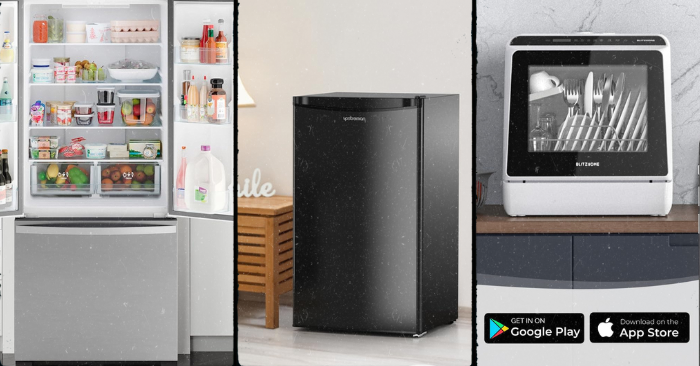Save Money, Reduce Energy Consumption, and Lower Your Carbon Footprint
Energy efficiency is about using less energy to achieve the same result. By adopting a few simple strategies, you can significantly reduce energy consumption at home, lower your carbon footprint, and save money on utility bills. These changes may seem small, but they contribute to a healthier planet and a more sustainable lifestyle. Let’s explore how energy efficiency works and how you can implement these strategies in your daily life.
1. Use Energy-Efficient Appliances
Appliances account for a significant portion of home energy use, especially major ones like refrigerators, washing machines, and air conditioners. Choosing ENERGY STAR-certified appliances is one of the most impactful ways to increase your home’s energy efficiency. ENERGY STAR is a certification provided by the Environmental Protection Agency (EPA) that signifies products meet energy efficiency guidelines. Appliances with this label use 10-50% less energy and water than their non-certified counterparts.
- Refrigerators: An ENERGY STAR-certified refrigerator consumes less energy, maintaining the same cooling performance as traditional models but with less environmental impact. Some refrigerators also come with advanced features like automatic temperature control and energy-saving modes.
- Washing Machines: These models use less water and energy for each cycle. Over time, upgrading to an energy-efficient washing machine can result in substantial savings on both electricity and water bills.
- Dishwashers: ENERGY STAR dishwashers are designed to use less water and energy while maintaining performance. They also often include energy-saving modes for light loads or less heavily soiled dishes.
In the long run, switching to energy-efficient appliances can save you hundreds of dollars on utility bills and reduce greenhouse gas emissions.

Consider upgrading for a more sustainable home.
Upstreman 3.2 Cu.Ft Mini Fridge with Freezer
BLITZHOME Portable Dishwasher Countertop, WIFI Smart Dishwasher
2. Switch to LED Lighting
Lighting can account for up to 15% of your home’s electricity use. A simple, cost-effective way to cut down on your energy consumption is by switching to LED (Light Emitting Diode) bulbs or S14 LED Hanging Light Bulbs for Patio. LEDs use up to 90% less energy than incandescent bulbs and last up to 25 times longer. Their longevity also means fewer bulb replacements, saving you money in the long term.
- Energy Savings: LED bulbs convert about 95% of the energy they use into light, wasting very little heat. In contrast, traditional incandescent bulbs convert only 10% of their energy into light, with the rest lost as heat.
- Lifespan: LEDs can last between 15,000 and 50,000 hours. By switching, you’ll not only reduce energy use but also avoid frequently buying new bulbs.
- Customization: Many LED bulbs come with dimming features, allowing you to control the ambiance in your home. Others are available as smart LEDs that can be controlled through your phone or voice assistants, further optimizing energy use.
Replacing all the light bulbs in your home with LEDs may seem like a small step, but the cumulative impact is significant. If every household in the U.S. swapped just one incandescent bulb for an LED, it would save enough energy to power 2.5 million homes for a year.
Browse these high-quality LED bulbs on Amazon to make the switch to energy-efficient lighting today, also check for Rechargeable Light Bulbs Emergency Light Bulbs, they are great for those who suffer from blackouts.
3. Unplug Devices to Combat Vampire Energy
Even when turned off, many electronic devices and appliances still consume power if they’re plugged in, a phenomenon known as “vampire energy” or standby power. Devices like televisions, computers, game consoles, and chargers continue to draw energy as long as they are connected to an outlet. Over time, this waste of energy can add up, unnecessarily increasing your electricity bill.
To prevent vampire energy, make it a habit to unplug devices when not in use. Another effective solution is to use smart power strips. These strips automatically cut off power to devices when they detect that they’re in standby mode. Here’s how they work:
- Smart Strips: Advanced power strips sense when your devices are no longer in use and cut the power, preventing them from wasting electricity.
- Master Control: Some smart strips include a master outlet that controls other connected devices. For example, when your television (the master device) is turned off, the smart strip will cut power to other connected devices, like a sound system or DVD player.
Taking the time to unplug or switch to smart power strips can lead to noticeable energy savings over time, especially in homes with multiple electronics.
Affiliate Link: Check out these smart power strips on Amazon to start saving on standby power.
4. Upgrade Your Home’s Insulation
Proper insulation is crucial for keeping your home energy-efficient, especially if you live in a climate that experiences temperature extremes. Insulation helps regulate the temperature inside your home, keeping it warm in winter and cool in summer without over-relying on your heating or cooling systems. According to the U.S. Department of Energy, 20-30% of heating and cooling energy is lost through poorly insulated walls, roofs, and floors.
- Attic Insulation: Heat rises, so your attic is one of the most important areas to insulate. Proper attic insulation can prevent heat from escaping during winter and keep your home cooler during summer.
- Wall Insulation: Insulating exterior walls can reduce drafts and make your heating system more efficient.
- Sealing Gaps: In addition to insulation, sealing air leaks around windows, doors, and ducts is essential for preventing energy waste.
By upgrading insulation and sealing gaps, you’ll use less energy to heat and cool your home, reducing your utility bills and your carbon footprint.
5. Install a Programmable Thermostat
Another energy-saving strategy is to install a programmable thermostat, which allows you to set specific temperatures for different times of the day. For example, you can program the thermostat to lower the temperature when you’re asleep or at work, and raise it when you’re home. This helps reduce energy waste without sacrificing comfort.
Some smart thermostats even adapt to your habits and can be controlled remotely via smartphone, allowing you to adjust the temperature based on your schedule.
Affiliate Link: Check out these programmable thermostats on Amazon to better manage your home’s energy use.Tip: Browse these high-quality LED bulbs on Amazon to illuminate your home efficiently.
3. Unplug Devices: Combat Vampire Energy
Even when turned off, many electronics, chargers, and devices continue to draw power if left plugged in, a phenomenon called “vampire energy” or standby power. Over time, this can lead to unnecessary energy waste. Unplugging devices when not in use, or using smart power strips, can eliminate this energy loss.
Smart power strips automatically cut off power to devices when they’re not being used, helping you save energy effortlessly. Consider these smart power strips for your home:
- Smart Power Strips: These advanced power strips sense when devices are idle and stop drawing energy, saving money and reducing your carbon footprint.
Tip: Check out these smart power strips on Amazon to prevent vampire energy in your home.
Discover more from Bee Newz
Subscribe to get the latest posts sent to your email.

